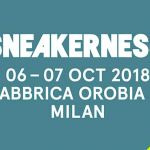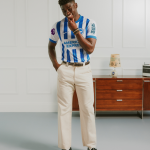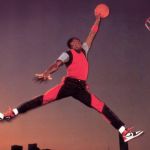
Gratitude, even though these days its very rare, is something to be cultivated.
I realize that talking about gratitude in this specific field might sound a bit strong, but for someone like me who grew up with a passion, that sometimes turns into obsession, for what is simply defined as a shoe, absit inuria verbis, the gratitude for those who, with a prophetic vision, changed forever the history and destiny of what we wear on our feet, gratitude is mandatory. This weekend Sneakerness, the biggest sneaker fair in Europe, comes to Milan. Another chapter in the history of this world that more than ever underlines how much this trend is at its peak. When in 1993 I bought my first sneaker, being very aware of what I was doing, all this was not even conceivable, I would have never thought that the sneakers market would have evolved in this way, but not everyone knows the origins and how this all began. That’s why nss magazine and I have decided to tell you how everything started and how an Italian-American forever changed the history of sneakers marketing and streetwear thanks to a “simple” vision.
My gratitude goes out to an Italian-American who would organize basketball tournaments for high school kids, named Sonny Vaccaro. No, he’s not a character from The Soprano’s, but first things first. We took advantage of Ronald Lazenby’s beautiful book “Michael Jordan, the life”, one of the best books ever written about an athlete, to look into the topic.
Through Lazenby’s tale and the words of the protagonists, we’ll bring you back to 1982 to learn about the story of the vision that forever changed the history of Nike, of sneakers marketing and sportswear.

SONNY
The first time Nike’s lawyers met Sonny Vaccaro they wondered if he belonged to the mob. Certainly his look was misleading, as was his name, accent, his extravagant way to do and, above all, that look on his face, as if he knew secrets and things normal people couldn't have possibly known. Michael Jordan had the same feeling when he first sat down at a table with that dumpy Italian-American with those hangdog eyes. “I’m not sure I want to have anything to do with such a shady guy” admitted Jordan. He liked the idea that people thought he had connections: in business, everything can be useful.
The truth is that Vaccaro had connections with men wearing tacky suits, but they were not part of the mob, they were basketball coaches.
“In 1978, in the basketball world, with the right amount of money you could get in good with many people. Sonny Vaccaro would have turned Nike in the living proof of this axiom.”
Sonny Vaccaro revolutionised sports and the marketing revolving around it while remaining himself and staking everything he had earned in his life. To fully understand how someone like Vaccaro ended up working with a company like Nike we need to look at the six months a year Sonny would spend in Pittsburgh.
He was only 24 years old in 1964 when, along with his collage roommate Pat DiCesare, he founded the Dapper Dan Roundball Classic, one of the first and soon to be one of the most prestigious school basketball tournaments.
The fortune was that this type of event would meet a specific need, that of being a showcase for high school kids to be seen from colleges and be recruited. In a very short time, it was possible to on the sideline see coaches like John Wooden and Dean Smith (the latter was Michael Jordan’s coach in North Carolina and his “second father”). Vaccaro never managed to earn big amounts of money with these tournaments.
But it was a real goldmine when it came to connections. Vaccaro became friends with the most important basketball coaches.
For Sonny, all that mattered was marketing and being able to have celebs on the sideline who would bring media themselves.
In 1970 Sports Illustrated published a report on Vaccaro’s activity: It’s impossible to walk around the William Penn Hotel without stumble upon coaches looking for high school players: in the hall, in the hallways, at the bar, in the lift, sometimes even under a palm tree….Vaccaro had eight ongoing conversations at the same time with eight different people, in different spots of the room: he was able to entertain everyone with the same respect, even though he was speaking with all at the same time.
At the end of the 70s, Vaccaro could boast a good level of visibility and an enviable level of confidence, which led him to the next step. In 1977 he telephoned the Nike offices in Portland, Oregon, to propose an idea for a new shoe. The proposal was kindly turned down but Rob Strasser, one of the highest managers of the company, who was astonished of all the connections Vaccaro had gathered with all the college basketball coaches.
However, he hired Vaccaro for a monthly wage of 500 dollars, put 30k dollars on an account at his disposal, and asked him to turn the coaches into Nike testiomonials…For him it was a piece of cake: he proposed to the coaches simple deals with Nike, signed checks and sent them free sneakers to be worn by players.
At the time 5k dollars, the amount of money Sonny used to give to the coaches, was a big batch of money, and for the coaches, it didn’t seem real. “So, let me get this straight: you give me free shoes and you even pay me? Is this legal?” asked coach Valvano, for example.
It was legal, but from an ethical point of view it made a lot of people raise eyebrows. The basic idea was easy: making amateurs wear Nike technical apparel in order to send a loud and clear message to both fans and costumers. When an Indiana State player, Larry Bird, appeared on the cover of “Sports Illustrated” wearing a pair of Nike, Vaccaro’s credibility reached the next level.
The Washington Post published an article that questioned the ethics of Nike’s system and the corporate executives were worried about the bad publicity. Instead, the answer was the exact opposite, they received an incredible number of requests from coaches that wanted to get their hands on the business too.
THE VISION
In 1982 Sonny Vaccaro was lucky enough (luck largely earned) to be invited by John Thompson to the Final Four in New Orleans. The Final Four of 1982 were no common Final Four, assuming that there are any, but where the ones in which, during the decisive timeout in the final seconds in the final against Georgetown, down by one, Dean Smith gave to a young Michael Jordan and North Carolina the opportunity to write the first chapter in the novel on the history of sports, his life. The exact words he told him were “Knock it in, Michael!”. In fact, the last shot gets to Michael, the tongue is out and Georgetown's defensive rotation is slow. Two points. The last Georgetown possession ends with nothing and Carolina is the champion. The prize for the best player went to James Worthy but it was another player who had stolen the show for Vaccaro, and it was the number 23 player who took the decisive shot, Michael Jordan.
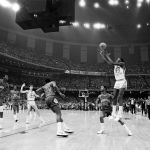
“Something had happened in front of the entire world” he said. A star was born, but only a very few people were aware of it. Sonny didn’t personally know Michael and Dean Smith had a deal with Converse, which Tar Hells would wear during the games. Since not everything was clear from the beginning, Jordan loved everything that was labeled adidas, especially the shoes, because you could play with them immediately out of the box, without the need to soften them. So Michael would wear adidas during the practice, to then change into Converse for the official matches.
Vaccaro was conviced that charisma could have turned that kid into a marketing sensation. He wanted Nike to sign him and design a collection exclusively for him.
He mentioned this to the Nike executives during a meeting in January 1984, Jordan was in his third year with North Carolina and he didn’t know yet whether he was going to remain there for another year, or if he was going to make the big step in the NBA.
The corporate executives granted a 2 millions dollars budget to include some young talents, for example Charles Barkley…The idea to spread the budget among a series of young players, during the 1984 draft, had its logic. “Don’t do it!” said Vaccaro to the managers. “Give everything to that kid. Give everything to Jordan.”
Vaccaro explains: “My position was: all the money we have, just give it to him”, Rob Strasser (Nike executive until 1987) would listen silently until he said “Would you bet your salary?”, and the answer was “Yes!”.
Everyone in Nike trusted Vaccaro’s intuition, but they had doubts about that bet, also because to get that investiment going and especially to work required diffrent things. Nike needed to basically create a unique product line supported by advertisement and a very impactful branding.
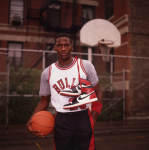
THE NEGOTIATION
At the time basketball marketing strategies revolved around teams as a single entity, and not around single players, while for Jordan the idea was to create something totally different. He had to be “sold” like a tennis player, like a single athlete. At this point, the idea had to be submitted to the person concerned, Michael Jordan. In August 1984 Rob Strasser and Peter Moor, Nike creative designer, met for the first time to discuss the project, while David Falk, 23’s agent, had written down some ideas for the name of Jordan’s shoes and clothing. One of the names on that list was “Air Jordan”. Those two words conquered everyone, immediately. Moore, at the end of that meeting, had already done a sketch of the logo, a crest with two wings holding a basketball and the words AIR JORDAN.
Now came the hardest part, convincing the Jordan family.
Michael was 21 and at the time and he was an immature kid who was not interested in the shoe market at all. Vaccaro turned to his old friend George Raveling, assistant to the coach Bobby Knight, the coach of the National team that would have later won the Olympic gold metal, to approach Jordan precisely during the LA Olympics.

“We met at Tony Roma, George brought Michael and introduced me” remembers Vaccaro. “It was the first time in my life I met Michael. We sat down and talked about him and Nike. He didn’t even know what Nike was. You have to believe me. I said to him, Michael, you don’t know me, but we are going to design a shoe just for you. No one had a shoe just for him, not yet.” Since not everything was clear from the beginning, it wasn’t love at first sight, on either sides. Vaccaro and Jordan did not like each other and this became even clearer when Jordan, ignoring everyone and everything, asked Vaccaro if he could have a car.
Vaccaro answered him “If you sign this contract, you will have as many cars as you wish.”
“I want a car, now” said Jordan.
Michael didn’t want to sign with him, he wanted adidas, because at the time it made the best tracksuits. They didn’t talk about money, also because Vaccaro kept telling him that he shouldn’t worry about it since if that deal succeded he was going to become a millionaire. But there was nothing he could do, Jordan wanted a new car. If Michael wanted a car, Vaccaro was going to get him one. “We’re going to get you a car, ok?”. Jordan didn’t answer, he just smiled. “You know, Michael has that smile… he looks at you and smiles in his ambiguous way, you never know what it means” remembers Sonny. Meanwhile, Falk was also talking with Converse and Adidas and while the agent was closing the deal with the Bulls, Nike knew that its offer was way superior compared to its competitors and at that point, Jordan would have realized how absolutely incredible that was. The day after the USA team won at the Olympics, negotiations began. The entire budget on Jordan: two and a half million dollars spread over five years, between prizes, annuities and bonuses. In terms of sneakers, for NBA players, this deal was absolutely without precedent, also because Nike granted Jordan 25% of profits for every shoe sold. That contract was the biggest bet ever made. Jordan had never played with pros, he could have suffered, Bulls at the time was a mismanaged team that lived in the shadow of cocaine parties, so popular in 70s NBA.
Everything revolved around an intuition, a vision, by Sonny Vaccaro.
The day came for the Jordan family to go to Oregon, but Michael called his mum and told her he was not going to leave. He was tired of travelling and the last thing he wanted was getting on a plane for a shoe he didn’t even like. Deloris Jordan did what a mother has to do, told her child to not throw a tantrum and to show up at the airport on time the next morning. As a good son, Michael listened to her.
Everyone was at that meeting, even Phil Knight came at a certain point (Nike president and co-founder). The main role in the negotiation was Deloris’s. “She was the one negotiating for her son, for the kind of life Michael was going to live.” During the entire presentation Jordan did not say a word, as if he was not interested and maybe it was true.

The only words he spoke, after having seen the red and black shoes, were: “Red… the color of the devil.” Vaccaro told Deloris Nike was going “all-in” on her son, “that’s exactly what I said to her, and I’m glad I did: we bet it all. I myself was betting my job and Nike was betting on its future, it was an incredible situation. It was all about the budget. For Michael’s mother, it was like becoming part of the family, if we were willing to put ourselves out there up to that point.”
“So you’re turning my son into the future of this company?” asked Deloris.
The answer was: “If Michael is not with us, we’ll fail.”
THE DECISION
To make everything happen, they had to convince that smartass and mouthy kid that the deal was good, also because he was going to make more money with Nike than with the Bulls. Jordan was not convinced yet, he kept remaining silent, then turned to Vaccaro and asked again for a new car. Sonny pulled out from his pocket two mock-ups, one of a Lamborghini and said “Michael, there’s a moment in life when you have to trust people.” At the end of the meeting, Nike had no idea of what Jordan thought of the presentation. After dinner, in a high-class restaurant where Michael felt perfectly comfortable, he was given an edit of his best moments at North Carolina and then he watched the Air Jordan presentation video again.
The deal had yet to be signed, but a connection was made, and the feeling was good.
There were the final approaches from Converse and Adidas, but they could have never reached Nike’s offer so they pulled back. One of Vaccaro’s greatest intuitions was not that Jordan would have become such a player, but that his magnetic personality was going to sell everything with his name on it.
Finally, in autumn, the deal was signed.
TURNING POINT
Now we have to stop for a moment, though, because this is an incredible, historical moment.
In my opinion this moment should be put in all school textbooks, framed and hung at the MoMa because this is the moment that laid the ground, not only for one of the biggest fortunes of all time but also for everything that happened in the sneaker marketing world to this very day and for the days to come. Marketing and branding strategies created during that meeting influenced everything revolving around the sneaker world on all levels. This was happening in 1984, and 34 years later things evolved in a totally unexpected way. Up until the mid 2000s everything passed from TV and newspapers, Nike commercials became iconic, they ruled and dictated the rules in this field. I still remember when everything revolved around basketball and Spike Lee’s commercials, and we, basketball enthusiasts, would enter our favorite shops, there was this unique smell. There were no official stores (at least in my city) and little retailers where the only connection with a very distant world.
TODAY
Now the landscape has completely changed, not nerdy basketball enthusiasts obsessed with Jordan anymore but kids that never heard of basketball and would do anything to get their hands on a pair of Air Jordan 1, like standing in line for days. One of today’s most influential designers, Virgil Abloh, won the Footwear News Achievement Awards (FNAA) as “Shoe of the Year” on 2017 with a deconstruction and renovation work on the iconic AJ 1 “Chicago”. The reselling phenomenon revolutionized the entire sneakers market, with the creation of consignment stores all over the world. Stores like Flight Club and Stadium Goods, Dropout in Milan, events like Sneakercon and Sneakerness became a reference point for the lovers of this world.
Today sneakers marketing is all about exclusivity, about owning a model instead of another, what drives costumers is not the story behind the shoe anymore, but it’s the so-called hype, the anticipation for a sneaker, in fact, it’s been years since we last saw one of those wonderful Nike commercials. Due to social media everything changed, influencers dominate the scene wearing the sneakers we so eagerly want but can’t have. We find ourselves in the most classic History in the making, we see the history changing in front of our very own eyes and as it’s right, we don’t know where it will take us. What are the risks? Overexposure, the excess that gets old. The most classic of bubbles, that is about to explode, even though personally I don’t think it will happen very soon. We are full of releases, drops and so much more we can’t keep up, to get a shoe we find ourselves playing with apps on the phone, use tricks like bots etc. The sneaker game got incredibly complicated and the rules keep changing, and risk to bore people like me who are used to something else. I’m not criticizing the structure, I’m just trying to understand this moment from my point of view, of a 36-year-old man who loved to go to the store, ask for a pair of shoes and bring them home. I miss the simplicity, nothing more, but I’m afraid that going back is impossible, because, as Bruno Munari once wrote, one of 20th century’s most promiment design and graphics figures, “Complicating is easy, simplifying is difficult.”


